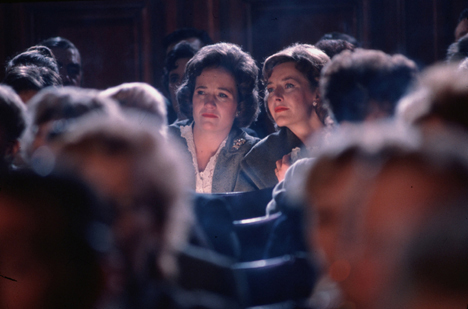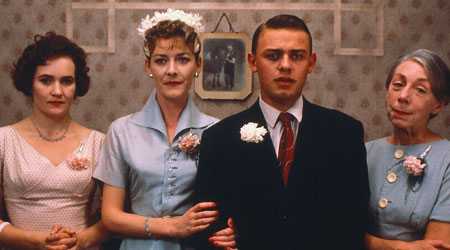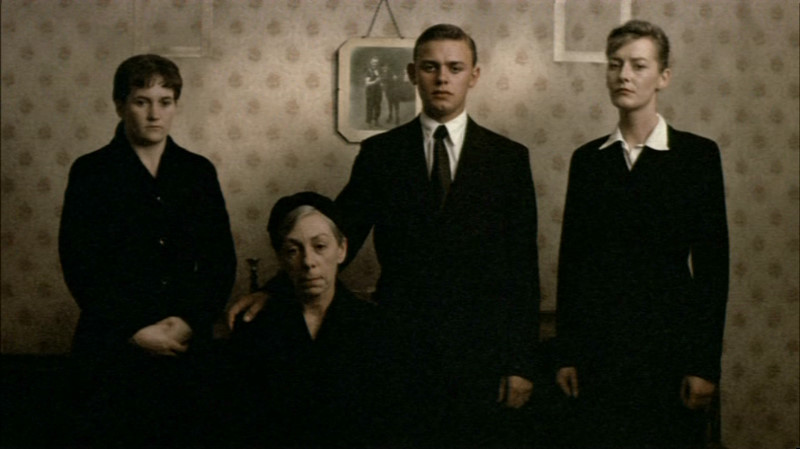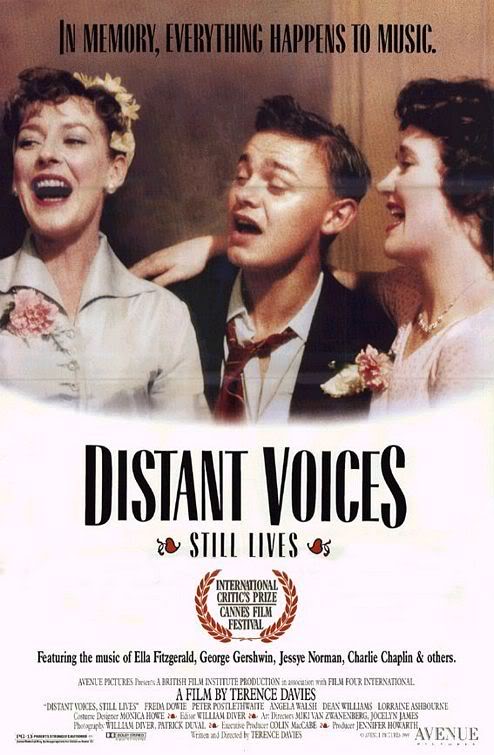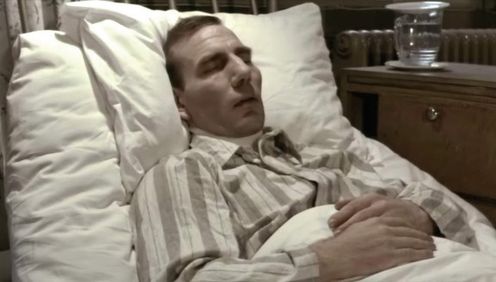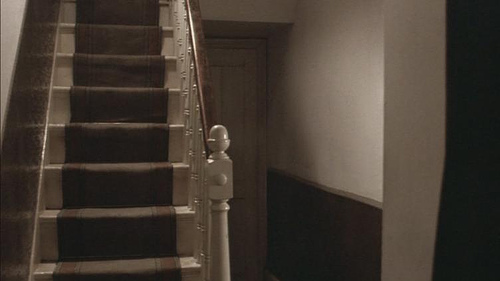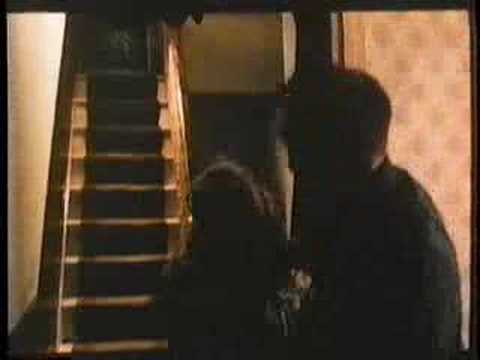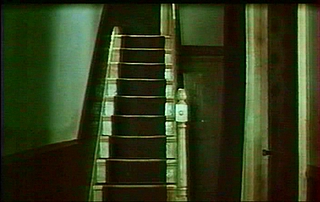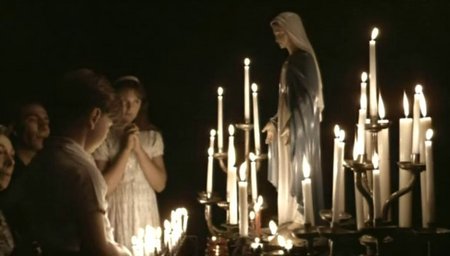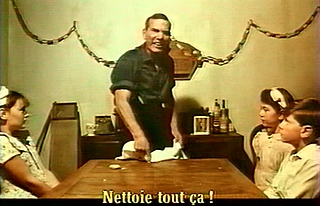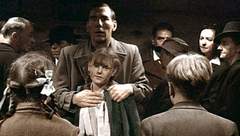From the August 18, 1989 Chicago Reader; this piece is also reprinted in my collection Essential Cinema. — J.R.
DISTANT VOICES, STILL LIVES
**** (Masterpiece)
Directed and written by Terence Davies
With Freda Dowie, Pete Postlethwaite, Angela Walsh, Dean Williams, Lorraine Ashbourne, Debi Jones, Michael Starke, and Vincent Maguire.
An autobiographical film about growing up in a Catholic working-class family in Liverpool in the 40s and 50s. Achronological glimpses of a traumatic family life, with particular emphasis on a funeral and two weddings. A collection of radio shows and nostalgic songs sung at parties and pub gatherings. A highly condensed, triple-distilled family album of faces and feelings organized around a few key locations. A series of emotional and visceral jolts whose brute power and intensity could not be conveyed by a conventional linear story. A seamless block of passionate memories defined by the beauty and terror of the everyday.
The problem with all these descriptions of Distant Voices, Still Lives is that though each is partially accurate, they only dance around the periphery of what is a primal experience; that they represent the shards of my attempts to describe the essence of a masterpiece that reinvents filmgoing itself. I saw it twice at the Toronto film festival last September, and twice again earlier this month, and the inadequacy of my efforts is largely due to the fact that great films have a way of imposing their own laws and definitions that ordinary descriptions can’t reach.
Take the word “autobiographical,” for instance, which usually implies that the author is the central character. Director Terence Davies (who was born in 1945) doesn’t represent himself in the film at all, and while I’m told that he was the youngest in a family of nine children, the family in the film has only two daughters and a son. (On the other hand, the photograph of the father on the living room wall — a pivotal reference point — is a photograph of Davies’s own father, not of the actor who plays him.) Davies’s only previous film work, which I haven’t seen, is a trilogy in black and white, also described as autobiographical, made between the early 70s and the early 80s, whose separate parts are called Children, Madonna and Child, and Death and Transfiguration. A friend who has seen this trilogy says that Davies himself is the central character, but that character dies at the end of the third part, so obviously it isn’t strictly autobiography either. (Davies also has written one novel, Hallelujah Now, published in 1984.)
Or consider the word “achronological.” The emphasis of emotional continuity over narrative continuity, the hallmark of several films directed by Alain Resnais (including Hiroshima, mon amour, Last Year at Marienbad, Je t’aime, je t’aime, and Providence), is certainly present here, but at the same time the overall film is structured around a certain narrative progression. The first part, “Distant Voices,” pivots around the funeral of the father (Pete Postlethwaite) and the wedding of the older sister, Eileen (Angela Walsh), both in the early 50s. It includes memories of an air raid during World War II (in an underground shelter the father orders the child Eileen to sing something; she responds with the “Beer Barrel Polka” and is gradually joined by all the others), and ends with the birth and baptism of Eileen’s first child. The second part, “Still Lives,” carries us through the wedding of the younger sister, Maisie (Lorraine Ashbourne), and ends with the wedding of Tony (Dean Williams), the youngest of the three siblings.
The film’s two parts — both produced by the British Film Institute in conjunction with England’s Channel Four — are actually two separate films from a production standpoint. “Distant Voices” was shot over four weeks (in London and Liverpool) in the fall of 1985, and “Still Lives” was shot over four weeks exactly two years later; the aging of the cast during the interim is often visible, and adds appreciably to the overall sense of the passage of time.
Stylistically, the two parts form a coherent whole, apart from the frequent use in the second part of fade-outs to white. Both sections were processed in the lab in a highly distinctive manner that leaves the silver nitrate in the print and desaturates colors in order to emphasize textures; the same process was used in Nineteen Eighty-Four to emphasize grays and blues. Davies employed various filters and gels in order to highlight the browns and implemented this strategy further by using costumes in earth tones.
The film opens with the sound of thunder and rain followed by a radio announcer giving a weather report; then we see a frontal shot of the Davies house in the rain, and the mother (Freda Dowie) opens the front door to collect three bottles of milk. In a closer frontal shot inside the house, she calls up the front stairway to her three children to come down to breakfast (“It’s seven o’clock”), then returns a moment later to call them again. The camera remains fixed on the empty stairway, though we hear the footsteps and voices of the children descending. A woman’s offscreen, unaccompanied voice begins to sing “I Get the Blues When It’s Raining” as the camera slowly moves forward, then turns right and makes a 180-degree pan to the closed front door, and the sound of the rain outside starts up again.
There’s a dissolve to the same front door, now open to clear weather; a hearse slowly pulls up in front (as we soon discover, it’s about ten years later), and another offscreen, unaccompanied female voice begins to sing “There’s a Man Goin’ Round Takin’ Names.” This continues over a dissolve to the children, now grown –standing with their mother as if posing for a portrait in front of the photograph of the father, which the camera slowly approaches as the figures in the foreground step away.
Another shot shows the four remaining members of the family entering the hearse, followed by a dissolve to the same family posing again, in the same spot, this time for Eileen’s wedding. Over the sound of rain again, Eileen says, “I wish me dad was here,” to which Maisie replies, “I don’t.” There’s an offscreen aural flashback to a quarrel between Maisie and her father about her wanting to go to a dance, a quarrel that a moment later we see as well as hear: Maisie is scrubbing the floor in the cellar, and the brief scene ends abruptly with the father tossing coins on the floor and then beating her with a broom.
Nothing in the above summary can convey the weight, the flow, or the impact of these sounds and images; they create a world of their own that is so self-sufficient and distinct from other film experiences that it is impossible to say whether this sequence — or any subsequent ones in the film — is proceeding quickly or slowly. We all know that “real time” and “film time” aren’t the same thing, but the emotional time of recollection that this film works with is so singular that it doesn’t seem to bear much relation to what we ordinarily mean by either of these temporal registers. The film as a whole lasts only 85 minutes, but the density that it conveys is closer to that of a three-hour epic.
English kitchen-sink realism is not a mode for which I have much affection, and while there might be some academic relationship between Distant Voices, Still Lives and such hallmarks of that mode as This Sporting Life, Saturday Night and Sunday Morning, The Loneliness of the Long Distance Runner, A Taste of Honey, and Georgy Girl, I think that such a comparison winds up confusing a lot more than it clarifies. “Technically” speaking, Davies’s film is closer to the avant-garde, and its emotional impact bears more relationship to the films of directors like John Ford, Yasujiro Ozu, Robert Bresson, Charlie Chaplin (whose Limelight theme is played by Tony on the harmonica), Kenji Mizoguchi, and Leo McCarey.
It isn’t surprising, however, to learn that Davies loves Hollywood musicals, and that a shot of black umbrellas in the rain in front of a movie theater is included as a specific reference to Singin’ in the Rain, the first film he ever saw. (The same shot pans up to posters advertising Love Is a Many Splendored Thing and Guys and Dolls, and the following shot is a pan across a large audience watching the former — the tearjerking theme song is heard offscreen — that finally settles on the weirdly lit figures of Maisie and Eileen, sobbing uncontrollably.) Though an independent British feature, Distant Voices, Still Lives ultimately harks back to an era in Hollywood filmmaking when strong emotions could be both expressed and elicited more directly, without shame, and the role of music throughout the film remains firmly within this tradition. Indeed, not only the offscreen songs cited above but also countless tunes sung by major characters, at parties and in the local pub, command a surprisingly yet justifiably large amount of the film’s attention.
For this reason, I strongly disagree with several critics who have tried to draw a parallel between Davies’s use of period pop songs and the ironic musical excursions in works by Dennis Potter such as the miniseries The Singing Detective and the movie and series Pennies From Heaven, which uses these touchstones in an antithetical way. Potter treats these songs as lies, and he uses them to point up their falsity in relation to the wretched lives of his characters. The bitterness and defeatism of his vision is not very far from the positions assumed toward soap opera by Douglas Sirk in the 50s and by Rainer Werner Fassbinder in the 70s — a form of cynicism that can only deal with strong emotions and sentimentality by placing them (implicitly in Sirk, explicitly in Fassbinder) inside quotation marks.
Davies, like Chaplin and McCarey, regards strong emotions and sentimentality as authentic and even indispensable tools for understanding and dealing with life. This can be seen in the sequence when Davies’s use of pop music is superficially closest to Potter’s. One of the daughters, as a little girl, is watching her mother, seated on a second-story windowsill, wash the outside of the window. A cut to a reverse angle shows the mother washing the same panes from inside the house, and as the camera slowly tracks toward her, we hear Ella Fitzgerald singing her dreamy version of “Taking a Chance on Love.” The song continues over an abrupt jump cut to a different scene downstairs, in which the father grabs the mother, dragging her and beating her to the floor (out of frame), repeatedly screaming “Shut up!” in response to her cries of pain. Then, as the song continues to the end of the chorus, another jump cut shows the mother’s bruised face in profile, followed by a slow pan down to her bruised arm as she polishes the furniture.
If the same action and the same recording were used in a Potter film, it seems likely that the Ella Fitzgerald record would be heard only after the mother’s beating, and that the mother would lip-synch the lyrics — that is, the ironic truth of the song’s lyrics (“Here I go again . . .”) would be used to ridicule both the pathos of the mother’s predicament and the inadequacy of those lyrics in dealing with that predicament. Davies, on the other hand, clearly loves both the song and his mother, and uses the record as a hymn to her courage and endurance — a hymn that in no way reduces the unbearable harshness of the beating; it allows us to hear the song’s lyrics in an ironic fashion without leading us to feel any contempt for them or for the feelings they represent. It is an extraordinary moment, and without trying to suggest that this comparison necessarily invalidates Potter’s gallows humor when he uses similar materials, I think it can be argued that the sheer rawness and power of the emotions expressed here by Davies are outside of Potter’s range entirely.
In general, Davies’s sympathy and empathy rest more with the women in the film than with the men. This becomes particularly apparent in the pub scenes in “Still Lives,” when the marriages of Eileen, Maisie, and their friend Micky (Debi Jones) register as tragic curtailments of their solidarity with one another and of their innocence, which is represented by many of the songs that they sing together, including not only such white-bread standbys as “Buttons and Bows,” “That Old Gang of Mine,” and “Bye-Bye Blackbird,” but also such ethnic favorites as “My Yiddisher Mama,” “When Irish Eyes Are Smilin’,” and “Brown-Skinned Girls.” Implicitly, the husbands of Eileen, Maisie, and their friends are perceived as somewhat muted variations of the father. (“They’re all the same,” Micky remarks at one point. “When they’re not usin’ the big stick, they’re fartin’.”)
Perhaps for this reason, “Still Lives” doesn’t put the viewer through quite as exhausting an emotional workout as “Distant Voices”; once the father dies, something goes out of the film. This doesn’t prevent the latter half of the film from having peaks and revelations of its own — the protracted leave-taking after Tony’s wedding, which concludes the film, is one of the loveliest sequences I’ve seen anywhere — but the tone is less brittle and searing, more elegiac and stately. I’m reminded that the “climaxes” of two other masterpieces — the ball sequence in The Magnificent Ambersons and Judy Garland’s “The Man That Got Away” number in A Star Is Born — occur quite early in both films, and the remainder of the story in each case is largely composed of thematic recollections of that emotional peak.
We all go to movies for pleasure, and it appears that more people are going to movies this summer than ever before; but how often do we see the people in these movies enjoying themselves? The sheer pleasure shown by the women (and occasionally the men) while they’re performing songs throughout Davies’s film makes these moments into exquisite, sustained epiphanies — stretches of unabashed delight totally unlike the kinds of enjoyment that we can find in recent commercial movies. (I except the Joker getting kicks from his media crimes and mischief in Batman, and a few moments of manic glee experienced by Steve Martin’s character on a Little League field in Parenthood.)
I’m not just thinking of Batman’s melancholia, James Bond’s bitterness, or Indiana Jones’s frustration. I’m also thinking of the catalogs of physical and/or emotional punishment meted out to the characters in nearly all the movies I’ve seen this summer, including The Abyss, Dead Poets Society, The Karate Kid Part III, Lethal Weapon 2, Lock Up, A Nightmare on Elm Street 5, Scenes From the Class Struggle in Beverly Hills, Turner & Hooch, Uncle Buck, Weekend at Bernie’s, and When Harry Met Sally . . .
I’m not trying to deny that the characters in Davies’s film suffer a great deal as well; indeed, one believes in their suffering in a way that one doesn’t believe in the assorted woes of the characters in the other movies. But given the hype about how much “fun” the aforementioned Hollywood features are supposed to be — and the bias on the part of this culture that “art films” like Distant Voices, Still Lives are supposed to be dreary yet vaguely edifying experiences, rather like castor oil — it’s amazing how little real and sustained pleasure there is in the former movies, and how much we’re allowed to see and share with Davies’s people (how much, in fact, we’re able to luxuriate in their fleeting yet ecstatic happiness) in spite of all their grief. The sheer physicality of their songs, their laughter, their smiles, and even on occasion their tears makes one feel grateful to be alive; by contrast, even some of the more exciting moments in Indiana Jones and Batman make one feel like an invalid on sedation getting jolts of electroshock.
There’s nothing intellectual about Davies’s approach to his characters, and no analytical grids are placed over them, although the restriction of the action to a handful of recurring locations — mainly the front of the Davies house, the stairway, the living room, the children’s upstairs bedroom, the stable where the father works, a hospital ward, the local Catholic church, and the nearby pub — circumscribes our glimpses of the characters to only a few special areas, which intensifies the film’s highly elliptical manner. The area just outside the front door of the Davies house, for instance, generally represents a space of provisional escape or respite; it’s where Eileen, Maisie, Micky, and another friend, Jingles (Marie Jelliman) go to smoke cigarettes and chew the fat, where other family members go during parties to get a breath of fresh air, or where, during the day, the mother briefly baby-sits with a grandchild in a baby buggy. The film regards this zone as a kind of privileged site — not quite the world outside the house, but still free of the sense of confinement inside.
It is where we see Tony alone, inexplicably crying after his wedding — one of the many events in the film that seem complete despite their lack of narrative explanations or any framing context. Another is Tony’s apparently going AWOL as a soldier in order to come home and confront his father — an event that begins when Tony smashes the front window with his fist, and ends when he is arrested by MPs and winds up in military prison; we’re never told what occasions this incident, and it’s part of the film’s brilliance that we don’t feel deprived by this lack of information.
Perhaps the film’s unerring sense of what is essential and what is not can be traced partially to its budgetary restrictions — a monetary economy that produces formal economy, an attitude that is reflected in the work of other independent filmmakers (from Mark Rappaport to Peter Greenaway to Jim Jarmusch to Steven Soderbergh) and that most Hollywood filmmakers could learn a lot from. The most extreme instance of this economy yields one of the film’s most striking shots — an overhead shot that shows both Tony and Eileen’s husband George (Vincent Maguire) falling simultaneously in slow motion through adjacent sections of the same skylight. After one of the Toronto screenings, Davies explained that he needed to show that both Tony and George suffer industrial accidents that land them in the hospital (we learn from the subsequent dialogue that George fell from a scaffold, but aren’t given any account of Tony’s accident); he didn’t have enough money to shoot two accidents, so he wound up combining them in a single shot.
Davies’s explanation may sound capricious, but in fact this is far from the only nonrealistic shot in the film; the film’s emotional continuity grants Davies an enormous stylistic freedom, and he takes full advantage of it without ever compromising his vision. Just as many incidents are conveyed without narrative explanation, certain others have a hallucinatory power that suggests that they might represent dreams rather than literal events, and here again, Davies’s grip on his subject is so sure and absolute that no sense of loss or confusion results from this lack of clarification. One of the strongest sequences begins with Eileen sobbing in her husband’s arms in a pub after her wedding and crying, “I want me dad!” A slow pan to the left gradually leads us into darkness, and then, without any apparent break, across a candlelit church interior where the family is praying. This dissolves into a lovely tracking shot moving in the same direction past a row of houses at Christmastime, accompanied by choral music, that finally ends in front of the Davies house, where we see the father dressing the Christmas tree inside. He says good night to his children (it is now years earlier than the scene in the pub), then later checks in on them and sees them all sleeping together in one bed; he says quietly, “God bless, kids,” and attaches a stocking to their bedpost. We next see the whole family praying at their Christmas dinner, and the father, sitting at the head of the table, starts to shake uncontrollably; then, in a single motion, he pulls off the tablecloth and all the dishes with it and yells, “Hey! Clear this up!”
The nightmarish finality and brutality of this shot, so contradictory in relation to everything in the sequence that precedes it, registers as a shock but not precisely as a stylistic rupture. Because everything that we see and hear has the shape and feel of events sifted through memory, there is a chilling congruence between all of the shots and events; and while the source of this particular shot may be either an actual incident or a nightmare, it ultimately makes no difference — the effect and meaning are literally the same.
An equally creepy (if funnier) moment occurs when Maisie and her husband Dave (Michael Starke) are eating dinner together in the house where they live with Maisie’s grandmother. Suddenly the door opens slightly, and a man who looks very much like the father, dead for many years, appears with a candle, turns out the light, says (in a singsong drone), “I switched the light off — I don’t know whether I’m doing right or wrong,” and promptly leaves. When Dave asks Maisie who the hell that was, she explains it’s her Uncle Ted. A moment later, Uncle Ted and his candle are intercepted at the foot of the front stairs by the grandmother, who says chidingly, “Teddy, stop acting soft!” and blows the candle out, leaving us in darkness. It’s a delightfully macabre moment that never fails to get a laugh from the audience.
I haven’t the faintest idea what this scene actually signifies — its meaning is obviously lost somewhere in the dark recesses of the Davies family folklore — but its musical and plastic articulation as a piece of filmmaking is so irreproachably right that it communicates as directly and beautifully as a perfect line of poetry. It is impossible for me to imagine Davies’s film without the scene or to imagine it being realized any differently than it is here. Musically or dramatically speaking, it is nothing more than a brief, frivolous interlude, a moment of comic relief. But the awesome strength of Distant Voices, Still Lives as a whole is that it makes every moment necessary and indelible as well as beautiful. I have every reason to believe that years from now when practically all the other new movies currently playing are long forgotten, it will be remembered and treasured as one of the greatest of all English films.

